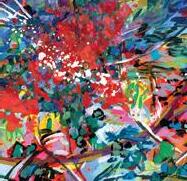Drawn into the Joy of the Gospel
Formation in the Archdiocese of Adelaide

© 2023 Catholic Archdiocese of Adelaide
39 Wakefield St, Adelaide SA 5000 www.adelaide.catholic.org.au
Artwork: Lisa Bierer, lisabiererpainting.com


Design: Archdiocese of Adelaide, Pastoral Services Team
An online version of this document and accompanying workbooks are available at: www.adelaide.catholic.org.au/our-works-and-community/ pastoral-services/publications
Dear sisters and brothers in Christ,
I commend to you this statement on formation in faith in the Archdiocese of Adelaide.
From the earliest days of his pontificate, Pope Francis has urged Catholics to become ever more vivid signs and instruments of God’s mercy, and to live the joy of the gospel. This has never been more urgent than in our day when we are faced with significant challenges in passing on our faith.
Francis’s call is addressed to every Catholic. Yet it is especially addressed to our communities. In his apostolic exhortation The Joy of the Gospel, he emphasises that it is the entire people of God who proclaim the gospel – not only individuals but parishes, communities, schools, and every group within them. He points out that the church is “first and foremost a people advancing on its pilgrim way towards God” (EG, §111).
This Archdiocesan statement, Drawn into the Joy of the Gospel, responds to Pope Francis’s call and aims to renew our diocesan community. Alongside the important work of the 2021 and 2022 Diocesan Assemblies, the 2023 Regional Assemblies, and the Fifth Australian Plenary Council, the statement asks how we can best foster the faith of each of our communities, listen to what the Spirit is saying to the churches, and live as missionary disciples.
A newly established Archdiocesan Commission for Formation will develop recommendations and strategies for the ongoing promotion of formation in parishes, schools, and communities.

The statement and accompanying workbooks have been developed under the direction of the Pastoral Services Team, who will support its implementation across the Archdiocese. I urge parishes, communities, schools, and every group in the Archdiocese to make Drawn into the Joy of the Gospel an ongoing focus for your prayer, reflection, and work. May it guide our common life into the future.


I delight in what God is doing among us because God is good; good indeed.
Yours in Christ,
+ Patrick O’Regan DD Archbishop of Adelaide




Introduction 5 Renewal in the Church 6 Formation in Parishes and Communities 7 Formation for Pastoral Ministry 8 Educators and School Leaders 9 Lay Diocesan Leaders, Chaplains, and Pastoral Associates 12 Consecrated Religious Women and Men 13 Deacons and Priests 14 Drawn into the Joy of the Gospel 15 Endnotes 16 Glossary 17 Further Reading 18 Contents
Joy is an unfathomable gift that seizes the imagination, leading us beyond ourselves and illumining the everyday with the infinite tenderness of God. Acceptance of this gift invites us to a deeper trust in the God who embraces our lives and our world in Jesus Christ — “What has come into being in him was life, and the life was the light of all people” (Jn 1:3–4). What Pope Francis calls “the joy of the gospel” flows from a personal encounter with Jesus.¹ This is a joy to be shared.
Disciples, transformed by God’s tender mercy, “have an endless desire to show mercy,” they are impelled to be missionary disciples (EG, §24). They know God’s love as the fundamental truth of their lives; indeed, it is the truth of the whole of creation and of history. Living God’s truth, disciples speak of it readily and seek to be agents of mercy in their own unique circumstances.

Every person’s encounter with Jesus Christ connects in some way with the believing community, the church. No one walks these paths alone. Parents, grandparents, siblings, and other family members are primary witnesses to faith and nurture a communion of love, the “domestic church.”² Couples, singles, and friends are equally agents of that loving communion. Parishes and communities, centred on the word of God and the Eucharist, are called to be beacons of joy in their own locales. Catholic schools educate students so that they can discover and be transformed by the faith that helps them to flourish as individuals and as essential members of faith-filled communities. In all of these contexts, and a multitude more, individuals experience the faith of God’s people and the mystery of the living God.
Drawn into the Joy of the Gospel outlines the Archdiocese of Adelaide’s commitment to foster the faith formation of the people of God in this place—that is, to provide opportunities that draw Catholics into a closer encounter with Jesus Christ, and thus ensure that we are “permanently in a state of mission” (EG, §25). The statement identifies essential facets of faith formation for parishes, communities, schools, diocesan agencies, and other Catholic organisations. In the context of the church in a missionary key, the statement considers formation for ministry: how can future pastoral associates, catechists, youth ministers, deacons, teachers, and priests best encounter Jesus Christ so that they can be ministers of the joy of the gospel?
5
Introduction
Renewal in the Church
Pope Francis, echoing the Second Vatican Council, identifies the church as “first and foremost a people advancing on its pilgrim way towards God” (EG, §111).³ Authentic pilgrimage requires all elements of the church to be open “to a constant self-renewal born of fidelity to Jesus Christ” (EG, §26). The Holy Spirit is the agent of this renewal. It is the Spirit who initiates and sustains the ongoing conversion of individuals, communities, and structures in the church for the sake of the church’s discipleship. There are two aspects of the community’s Spiritled pilgrimage that require particular attention.
First, the rapid cultural changes of the last sixty or so years call the church to be creative in expressing the deepest truth of the gospel to bring out its “abiding newness” (EG, §41). Sometimes, because of the changing context, older expressions of faith “may be beautiful, but they no longer serve as means of communicating the Gospel” (EG, §43). The multicultural nature of Australian society highlights a related dimension of this renewal. Because each culture is embodied in a particular language and way of life, we must find appropriate expression for faith in each of those cultures. Throughout history, Christian faith has been lived in countless different cultural forms, and this will always be its reality.

Second, the renewal of our common life must be fed by a deepening appreciation of both the scriptures and the tradition of faith. It is only in this way, Francis emphasises, that the judgement of the church will mature (EG, §40). The scriptures are the privileged vehicle through which God speaks to humanity; they are the word of God. The tradition preserves and hands on the scriptural word through the whole life and practice of the church. A deeper knowledge and love of both scripture and tradition are essential for the renewal of the ecclesial community. They provide sure guides for discerning how best to respond to new questions, and advance toward the fulness of God’s kingdom.
And further, Pope Francis has promoted synodality as an indispensable means of finding expression for the deepest truth of the gospel in this age. A synodal church is a church of shared discernment, of walking and listening together. Francis has urged the church to “a mutual listening in which everyone has something to learn. The faithful people, the college of bishops, the Bishop of Rome: all listening to each other, and all listening to the Holy Spirit.”⁴ As those words indicate, a widespread synodal culture will impact upon every dimension of Christian life. The ongoing formation of all members of the church must foster a synodal conversion.
6
Formation in Parishes and Communities





Because the joy of the gospel is a joy to be shared, parishes and communities seek to be agents of joy; to do so, they must be outwardfacing or mission-oriented (EG, §28). Our parishes and communities take many forms, some strikingly multicultural and others with a specific cultural identity. Pope Francis insists that vital parishes and communities are always going to the outskirts and to new sociocultural settings (EG, §30); they are in touch with the whole of their neighbourhood. Every pastoral activity in these communities must aim to be “more inclusive and open” (EG, §27), since “no one is excluded from the joy brought by the Lord.”⁵
Further, this outward-facing orientation also characterises how we proclaim the gospel. This is the task of evangelisation. The last sixty or so years have seen a major shift in the place of religion in Australia, a shift in the experience or conditions of belief. Leading sociologists speak of people today being more “seekers” for religious faith rather than “dwellers” in the mode of believing of a past age.⁶ If this is so, and it seems to be, then it is essential that parishes and communities proclaim the gospel in ways that respond to the searching hearts of their neighbours, enabling them to encounter the love of God in Jesus Christ through the Holy Spirit. As Pope Francis so evocatively states, evangelisation “is simply pointing to the source of authentic personal fulfilment” (EG, §10).
Parishes and communities find the primary source of nourishment for their mission in the celebration of the Eucharist. In celebrating the Eucharist, they open themselves to the word of God, give thanks for the gifts of life and faith, join themselves to Jesus’ offering to the Father, and are sent out to live the gospel in the world. Homilies have a pivotal role in this celebration. In attending to the scripture readings of the day, the homilist takes up the dialogue that God has already established with the community of faith
(EG, §137) and draws out its meaning for the present. As Francis says, “Christian preaching thus finds in the heart of the people and their culture a source of living water, which helps the preacher to know what must be said and how to say it” (EG, §139). Indeed, the celebration of each of the sacraments forms the community of faith.
The whole range of activities in parishes and communities fosters faith. Prayer groups of different Christian spiritual traditions draw individuals into a deeper relationship with the God of love; nurturing that relationship is the soul of parish life. Parish schools are integral parts of parish communities: the Sunday eucharistic community and the school community “are church together—a ‘parish’ together—with and for children, families, the poor and the world.”⁷ Those at pivotal points of the Christian journey are led into a fuller lived faith through sacramental preparation programs. Youth groups foster the lives and faith of the younger members of our communities. Social justice and Earthcare groups direct the community to Jesus’ call to transform the world in the light of the Kingdom. Other groups facilitate the community’s response to those who are hungry, thirsty, naked, sick, or in prison (Mt 25:31–46). Each of these aspects of parish and community life, in its own way, fosters the lived practice of faith.
Yet, integral to each of the above activities is a deepening knowledge and love of the biblical word and the living tradition of the church over centuries, which finds expression in the lived wisdom of believers’ lives. In every new context, parishes and communities must ask what their faith calls them to, and seek answers in the light of the scriptures and church teaching. This is an ongoing task. Hence, as the Second Vatican Council stresses, it is essential that communities of faith develop the biblical and theological literacy of their members.⁸
7
Formation for Pastoral Ministry


The vital task of fostering missionary discipleship in our parishes and communities is supported by the pastoral ministry of the archdiocese, led by our chief pastor, Archbishop O’Regan. The many pastoral ministers—teachers and school leaders, pastoral associates, catechists, youth ministers, hospital and prison chaplains, diocesan leaders, deacons, and priests—all have need of both initial and ongoing formation. The following sections outline the importance of that formation. While various pastoral services and bodies are discussed, these collaborate where possible and offer distinctive formation where necessary.

8
Educators and School Leaders
Catholic schools have been integral to the life of the South Australian community from the earliest days of the colony, and still hold that place today. Catholic Education South Australia (CESA) and its predecessor bodies have educated children and young people not only as participants in society but also as people of faith. The major social and cultural shifts of recent decades have presented new challenges for Catholic schools and for educators. In particular, the increasingly diverse cultural backgrounds and religious affiliations of students, parents, and families have demanded creativity and renewed attention to the faith formation of students, as well as the faith formation of teachers and school leaders.
The 2022 Vatican document The Identity of a Catholic School for a Culture of Dialogue encourages Catholic schools to embrace these challenges in three fundamental ways: bearing witness; cultivating knowledge; and fostering relationships of dialogue.⁹ First, Catholic schools bear witness to the love of God in Jesus Christ through the Holy Spirit; they approach the educational task inspired by the gospel. Faith is a gift that can never be imposed or demanded. Nonetheless, through the educational endeavour, “it is possible to create the conditions for a person to develop a gift for searching and to be guided in discovering the mystery of [her] being and the reality that surrounds [her] until reaching the threshold of faith.”10 That mystery—a “spark of divine light…within each of us,”11 as Pope Francis puts it—is celebrated in the Eucharist and in each of the sacraments. Catholic schools, therefore, must so embody and find expression for the love of God that their common life speaks clearly to people today.
Second, Catholic schools lead students to deeper knowledge through the physical, mathematical, human, philosophical, and social sciences. Teachers and school leaders create rich learning environments, catering for the various learning styles of their students, and leading them to further insight both into their own social and ecological context and into their place within it.12 This deep knowledge is not an end in itself but wisdom for the common good.
And third, since schools share in the evangelising mission of the church, the pattern of life in Catholic schools must be rooted in God’s deep dialogue with humanity. God has spoken to humanity through Jesus Christ and in the Holy Spirit, and dialogue draws believers into this divine conversation. More than a process or technique, dialogue is a “profound way of relating to others.”13 It begins with openness to another person, group, or culture, seeking to understand those others on their own terms. This openness leads dialogue partners to revisit their own “take” on the world, and to see that there is more to their own lives than they had previously thought. And through openness and re-learning, the dialogue partners are “transformed into a communion in which they do not remain what they were.”14 Deep dialogue leads learners into greater self-knowledge, communion with others, and communion with God.


Essential to this dialogue in schools, therefore, and to the church’s evangelizing mission, is the biblical and theological literacy of school leaders and teachers of religious education. A deep dialogue about the mystery of God at work in students’ lives cannot begin without teachers’ experience of that mystery in their own lives, and a sure knowledge of the scriptures and the Catholic theological tradition. Further, the dialogue extends beyond the religious education curriculum to every aspect of students’ learning. All things lead people to the mystery of Christ (Col 1:15–20). CESA strives to lead teachers and school leaders into deeper faith, expressed in a lived spirituality, so that Catholic schools might be places of rich dialogue.

9


Lay Diocesan Leaders, Chaplains, and Pastoral Associates


Lay pastoral ministry has been a strong feature of life in the Archdiocese of Adelaide since the Second Vatican Council, nurtured by the council’s understanding of the church as the people of God.15 It is an authentic calling for both women and men, and takes many forms including hospital and prison chaplaincy, service in diocesan offices and agencies, youth ministry, the ministry of catechist, and that of parish pastoral associate. Collaborating with the ordained, and co-responsible with them, lay pastoral ministers exercise leadership both within the Catholic community and beyond. The shifting patterns of belief in twenty-first-century Australia indicate that well-formed, capable lay leaders will be essential to the good functioning of parishes, communities, and the archdiocese into the future.
The formation of lay pastoral ministers addresses four key areas: those of human, spiritual, intellectual, and pastoral formation.16 Human formation fosters candidates’ emotional and psychological lives so that they might flourish as human beings. The spiritual formation of candidates for ministry draws them into a more intimate encounter with Jesus Christ, making available to them the range of the church’s spiritual practices, not only for their own good, but so that they have the capacity to foster the spiritual lives of those whom they will serve. With the intellectual aspect of formation, candidates are led to a fuller knowledge of the biblical and theological traditions so that they have the capacity both to give a convincing account of the hope that is within them (1 Peter 3:15) and to convey the good news of Jesus Christ to those whom they serve. Finally, the whole of candidates’ formation aims to prepare them for pastoral ministry, so that they might serve the believing community after the example of Jesus Christ. The many elements of practical or pastoral theology are caught up in this dimension of formation. Skill building and training is vital for particular ministries, including youth ministry and children’s sacramental preparation.
12
Consecrated Religious Women and Men

In the past sixty years, perhaps no group within the Catholic community has attended more judiciously to Vatican II’s call for renewal than consecrated religious—sisters, brothers, and priests. The council urged them to continually return to both the deepest sources of Christian life, and the original inspiration of their congregations’ founders, while adapting that inspiration to present conditions.17 Since the council, religious women and men have devotedly studied those founders’ lives and inspirations and have sought further education especially in fields of biblical studies, theology, and spirituality.
Yet the task of formation in the Christian life is ongoing, as Pope John Paul II affirms: it is “an intrinsic requirement of religious consecration.”18 John Paul identifies four dimensions of that ongoing formation, which parallel the four general areas of formation mentioned earlier: the personal, through which religious grow in interior freedom and maturity; the apostolic, through which they respond to the love of Christ in the poor; the cultural, through which they wisely discern the struggles of the present age; and the dimension of the charism, through which they deepen their own special consecration.
In 2015, Pope Francis urged religious women and men to embrace even more wholeheartedly the prophetic dimension of their calling. He wrote: “I am counting on you ‘to wake up the world’,”19 and urged religious to read the signs of the times so that they might denounce injustice and stand with the poor and powerless. He continued: “so I trust that … you will find ways to create ‘alternate spaces,’ where the Gospel approach of self-giving, solidarity, embracing differences, and love of one another can thrive.” Such a renewed commitment to discernment and prophecy ensures that the lives of religious are integral to the renewal of the archdiocese.

13
Deacons and Priests
The ministry of deacons took shape in the early church, having its source in the life, death, and resurrection of Jesus Christ. Vatican II called for its restoration as an element of the church’s ministry because the permanent diaconate had disappeared from the church’s practice for many centuries. Diaconal ministry has three interrelated dimensions: service, word, and sacrament. Deacons embody in a special way the truth that all ordained ministry exists for the service of the people of God and the wider world. Deacons are also ministers of the word. Through the proclamation of the gospel and preaching, they announce the good news of God’s unconditional love in their own time and place. And finally, deacons are ministers of the altar, particularly at the Eucharist, during which they bring the needs of humanity to the Eucharistic table and from that table respond to those needs. The program for the initial and ongoing formation of deacons responds to each of these dimensions.
Our priests are integral members and leaders of the Catholic community. They, too, are ministers of the joy of the gospel. The archdiocesan statement on priestly ministry, Eucharistic Living, speaks of priests as ministers of memory and communion.20


Gathered around the bishop, who symbolises the unity of the local church, priests are, firstly, ministers of memory. In the Eucharistic liturgy, priests gather the community of faith, all responding to Jesus’ command at the Last Supper: “Do this in memory of me” (1 Cor 11:24). The community recalls Christ’s life, death, and resurrection, and finds its own deepest meaning in his risen presence among them.
As mentioned earlier, homilies have a pivotal role in the Eucharist, as Vatican II teaches: preaching the gospel “is the first task of priests.”21 And further, priests mediate the memory of Jesus and his pastoral love through their various daily encounters. In this way, they live in love of him,
and draw others into that friendship. “Personal love for Jesus, the Jesus of the Gospels who is the Risen One, is at the very centre of our priestly ministry.”22
Second, in leading parishes, priests have a fundamental role of drawing parishioners into the communion which is the church, and which has its ultimate source in our God, who is a trinitarian Communion-in-love.23 Pivotal to this ministry of communion is the task of inviting parishioners into the various ministries that serve the church and the world—helping parishioners to discern where God is calling them, and enabling them to function in those ministries.
Yet priests are not only agents of formation, they are also in constant need of that same formation, growing in the knowledge and love of God through prayer, the study of scripture and the theological tradition, and through other secular disciplines required to meet parish and diocesan needs. This responsibility belongs to the presbyterate as a whole, gathered around the bishop, and to each priest, and is coordinated across the archdiocese.
14
Drawn into the Joy of the Gospel
The formation in faith of the whole people of God is integral to the life of the Archdiocese of Adelaide—it is fundamental to our being drawn into the joy of the gospel. Richer celebrations of the Eucharist, a deeper prayer life, greater insight into the scriptures, a fuller knowledge of the Christian tradition throughout the centuries—each of these will lead us to further embrace the tenderness of God. And in that embrace, we will have “an endless desire to show mercy” (EG, §24), seeking to transform our parishes and neighbourhoods. Formation in faith is, therefore, an ongoing, life-long task for the whole people of God—parishes and communities, and all who serve them as ministers in the church.

15
Endnotes



1 Pope Francis, The Joy of the Gospel (Evangelii Gaudium), (London: CTS, 2013). References to this document will be placed in brackets in the text: (EG, §#).
2 Vatican II, “Dogmatic Constitution on the Church (Lumen Gentium),” §11; Pope John Paul II, On the Role of the Christian Family in the Modern World (1981), §21.
3 Vatican II, Lumen Gentium, ch. 7.
4 Pope Francis, “Address at the Ceremony Commemorating the 50th Anniversary of the Institution of the Synod of Bishops” (Rome, October 17, 2015).
5 Paul VI, “Apostolic Exhortation Gaudete in Domino” (1975), §22. Cited in EG, §3.
6 See for example Hans Joas, Faith as an Option: Possible Futures for Christianity (Stanford: Stanford University, 2014).
7 Catholic Archdiocese of Adelaide and Diocese of Port Pirie, Being Church Together: A Theology, Vision, and Guiding Principles for the Parish–School Relationship (Adelaide: Archdiocese of Adelaide, 2023), 9.
8 Vatican II, “Dogmatic Constitution on Divine Revelation (Dei Verbum),” esp. §§7–13.
9 Dicastery for Culture and Education, “The Identity of a Catholic School for a Culture of Dialogue” (January 2022).
10 Dicastery for Culture and Education, “Identity of a Catholic School,” §28, citing Sacred Congregation for Catholic Education, “Consecrated Persons and their Mission in Schools,” (October 2002), §51.
11 Eugenio Scalfari, “The Pope: How the Church Will Change” (Interview with Pope Francis), La Repubblica (October 1, 2013).
12 Dicastery for Culture and Education, “Identity of a Catholic School,” §29.
13 Sacred Congregation for Catholic Education, “Educating to Intercultural Dialogue in Catholic Schools: Living in Harmony for a Civilization of Love” (2013), §57.
14 Hans Georg-Gadamer, Truth and Method (New York: Continuum, 1989), 379.
15 The Australian bishops have articulated such an understanding of lay pastoral ministry in: Australian Catholic Bishops Conference, Faithful Stewards of God’s Grace: Lay Pastoral Ministers in the Church in Australia (Canberra: ACBC, 2018).

16 These four areas are outlined by Pope John Paul II in Pastores Dabo Vobis (March 25, 1992). While that document deals with the formation of priests, the same four areas are widely accepted as most appropriate for formation in pastoral ministry.
17 Vatican II, “Decree on the Adaptation and Renewal of Religious Life (Perfectae Caritatis),” §2.
18 Pope John Paul II, “Post-Synodal Apostolic Exhortation Vita Consecrata,” (March 25, 1996), §69.
19 Pope Francis, “Apostolic Letter to all Consecrated People” (November 21, 2014).
20 Catholic Archdiocese of Adelaide, Eucharistic Living: An Applied Theology of Priestly Life in the Church of Adelaide (Adelaide: Catholic Archdiocese of Adelaide, 2010).
21 Second Vatican Council, “Decree on the Ministry and Life of Priests,” §4.
22 Archdiocese of Adelaide, Eucharistic Living, 4.
23 Archdiocese of Adelaide, Eucharistic Living, 5.
16
Glossary
Disciple/Missionary Disciple
Christian disciples are those who believe the teaching of Jesus Christ, share his life, and embody the gospel in their lives. A central facet of their discipleship is the summons to announce the gospel and further God’s reign—that is, “mission.”
Domestic Church
Vatican II’s depiction of the Christian family “in which parents must be for their children, by word and by example, the first preachers of the faith, encouraging each in her or his vocation” (Vatican II, Lumen Gentium, §11).
Eucharist
The sacramental celebration of Christ’s death and resurrection and his continuing presence in the lives of Christians, often called the Mass.
Evangelisation
The proclamation of the good news of the gospel, through which hearers are enabled to encounter the good news of Christ in a lifegiving, transforming way.
Kingdom/Reign of God

The central theme of Jesus’ preaching and whole ministry: that God’s unconditional love is breaking into and transforming the world through his ministry.
Lay/Ordained Pastoral Ministers
Ordained pastoral ministers—bishops, priests, and deacons—are initiated into the ministry of the church by a sacramental rite in which the Holy Spirit is invoked. Their ministry is linked to the ministry of Jesus and the apostles. Lay pastoral ministers are publicly authorised by the bishop for service and leadership in parishes and communities.
Mission/Missionary
The gospel summons to “go out” and further God’s reign in the world, and to announce the gospel to those who have not heard it.
Parish/Community
Parishes are stable Christian communities, usually a geographical section of the diocese, entrusted by the archbishop to the pastoral care of a priest. In this document, the word “communities” is used to designate the cultural communities within the archdiocese who have their own identity and gather to celebrate the Eucharist.
Pastoral Ministry
The activity of the church through which God’s shepherding care is expressed in the world.

People of God
A biblical image of the church central to Vatican II’s teaching; “a people advancing on its pilgrim way toward God” (EG, §111).
Second Vatican Council/Vatican II
The 21st general council of the Catholic Church, which met between October 1962 and December 1965. The most significant body of teaching in the Catholic Church since the sixteenth century.
Social Justice
That which is required for a just society and Christians’ faithfulness to the gospel. Since the late-nineteenth century, the church has a rich tradition of Catholic Social Teaching which responds to urgent social questions from the perspective of Catholic faith.
Tradition
Both the process of handing on the life and practice of the church, and the content of the church’s belief—all that the church is and believes (Vatican II, Dei Verbum, §8).
17
Further Reading
Australian Catholic Bishops Conference, Faithful Stewards of God’s Grace: Lay Pastoral Ministers in the Church in Australia (Canberra: ACBC, 2018).
Catholic Archdiocese of Adelaide and Diocese of Port Pirie, Being Church Together: A Theology, Vision, and Guiding Principles for the Parish–School Relationship (Adelaide: Catholic Archdiocese of Adelaide, 2023).
Dicastery for Culture and Education, The Identity of a Catholic School for a Culture of Dialogue (Rome, January 2022). Read here
Stirring the Soul of Catholic Education: Formation for (Mulgrave, Vic: Garratt, 2017).
Pope Francis, The Joy of the Gospel “Evangelii Gaudium,” (November 24, 2013). Read here







Pope Francis, On the Call to Holiness in Today’s World “Gaudete et (March 19, 2018). Read here.
Pope Francis, Post Synodal Apostolic Exhortation to Young People “Christus Vivit,” (March 25, 2019). Read here
Pope Paul VI, Apostolic Exhortation “Evangelii Nuntiandi,” (December 8, 1975). Read here

Robert Leavitt, The Truth Will Make You Free: The New Evangelization for a Secular Age (Collegeville, MN: Liturgical Academic, 2019).
United States Conference of Catholic Bishops, Co-Workers in the Vineyard of the Lord: A Resource for Guiding the Development of Lay Pastoral Ministry (Washington, DC: USCCB, 2005).
18

39 Wakefield Street, Adelaide SA 5000
GPO Box 1364, Adelaide SA 5001



pastoralservices@adelaide.catholic.org.au



adelaide.catholic.org.au


















































